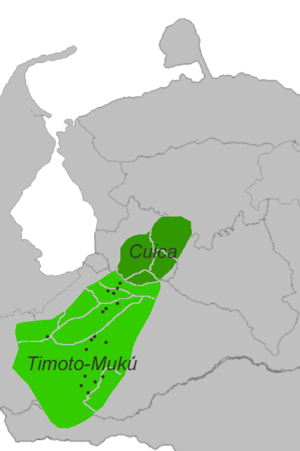Timoto–Cuica people
 Timoto and Cuica toponyms | |
| Total population | |
|---|---|
| extinct | |
| Regions with significant populations | |
| extinct | |
| Languages | |
| Timote-Cuica language | |
| Related ethnic groups | |
| Muisca | |
Timoto–Cuica people were an indigenous group composed primarily of two tribes, the Timote and the Cuica, that inhabited in the Andean region of western Venezuela.[1] They were closely related to the Muisca of the Andes, who spoke Muysccubun, a version of Chibcha. The Timoto-Cuicas were not only composed of the Timoto and the Cuica tribes, but also the Mucuchíes, the Migures, the Tabayes, and the Mucuñuques.
Culture and society
Pre-Columbian Venezuela had an estimated indigenous population of one million,[1] with the Andean region being the most densely populated area. The two tribes lived peacefully in what are today the states of Mérida, Trujillo, and Táchira.
Timoto-Cuica society was complex with pre-planned permanent villages, surrounded by irrigated, terraced fields. They also stored water in tanks.[1] Their houses were made primarily of stone and wood with thatched roofs. They were peaceful, for the most part, and depended on growing crops. Regional crops included potatoes and ullucos.[2]
They left behind works of art, particularly anthropomorphic ceramics, but no major monuments. They spun vegetable fibers to weave into textiles and mats for housing. They are credited with having invented the arepa, a staple in Venezuelan and Colombian cuisine.
References
Bibliography
- Mahoney, James. "Colonialism and Postcolonial Development: Spanish American in Comparative Perspective. New York: Cambridge University Press, 2010. ISBN 978-0-521-11634-3.
External links
| Wikimedia Commons has media related to Timoto-Cuicas. |
- (Spanish) Indigenous Culture in Venezuela
- (Spanish) De los timoto-cuicas a la invisibilidad del indigena andino y a su diversidad cultural
- (Spanish) Caciques de Venezuela)
- Get to know Venezuela